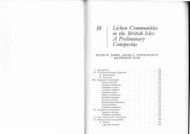You also want an ePaper? Increase the reach of your titles
YUMPU automatically turns print PDFs into web optimized ePapers that Google loves.
gray to brownish. Rare, on base rich substrates .<br />
. GS Physcia: Hyperphyscia<br />
45* Thallus K+ yellow, not closely appressed, <strong>of</strong>ten<br />
over 2 cm, underside (with exception <strong>of</strong> the lobe<br />
ends) black, upper side white-gray or light<br />
bluish-gray, rarely slightly brownish. Ap. usually<br />
lacking, brown, lecanorine. Sp. 1-celled,<br />
colorless 46<br />
46 Lobes hollow, narrow to wide, <strong>of</strong>ten with soralia,<br />
gray or bluish-gray, occasionally also brownish<br />
Hypogymnia<br />
46* Thallus lobes not hollow, narrow, high convex,<br />
closely crowded, sometimes ro<strong>of</strong> tile like,<br />
without soralia, usually light gray (<strong>of</strong>ten<br />
brownish overlaid). Underside black. On silicate<br />
rock in the mountains<br />
GS Hypogymnia: Brodoa<br />
(If alternative 46 not correct, see also GS<br />
Parmelia: a few species have at times very<br />
sparse rhizines)<br />
47 Ap. occurring. Key according to sp. characters .<br />
48<br />
47* Ap. lacking or occurring. Key without sp.<br />
characters 50<br />
48 Sp. brown to gray-green, 2-celled, ellipsoid, with<br />
usually partially thickened walls. Ap. usually<br />
blackish, sometimes pruinose GS Physcia<br />
48* Sp. otherwise, colorless (if colored, 4-celled, see<br />
bluegreen algae lichens) 49<br />
49 Sp. 2-celled, ellipsoid to fusiform. Ap. ± brown,<br />
protruding. Thallus small- and narrow lobed,<br />
brown, when moist light brown to deep green<br />
(with bluegreen algae) Massalongia<br />
49* Sp. 1-celled Key further at 51<br />
50 Rhizines viewed at right angles, bottlebrush-like,<br />
black (Fig. P. 729, there are always more threads<br />
attached to the rhizines than are shown, not only<br />
on young rhizines), underside black, only the<br />
margin sometimes pale. Thallus usually<br />
brownish, but <strong>of</strong>ten pruinose. (Sp. brown, 2celled)<br />
GS Physcia: Physconia<br />
50* Rhizines mostly simple or further divided, never<br />
bottlebrush-like 51<br />
51 Thallus shiny brown to shiny black-brown, not<br />
pruinose (only pruinose abnormally). (Sp. 1celled)<br />
52<br />
51* Thallus not shiny brown/black-brown . 54<br />
52 Thallus lobes long streaked and sometimes<br />
wrinkled, with ± peg-like to spherical warts with<br />
pycnidia at the margins, underside with sparse<br />
rhizines. On silicate rock in the higher mountain<br />
sites Cetraria<br />
52* Thallus lobes not wrinkled, without such warts<br />
on the margins 53<br />
53 Thallus undersid with sparse rhizines, pale<br />
brownish to almost whitish, almost pillow-form<br />
and thickly covered with ap. or with less dense<br />
granular-sorediate lobes projecting from the<br />
margins. Medulla and thallus R-. On bark and<br />
wood Cetraria (sep./chloroph.)<br />
53* Thallus otherwise, underside with sparse to<br />
numerous rhizines, light to black, not pillowform.<br />
Thallus/medulla R- or R+. On bark, wood,<br />
or rock GS Parmelia<br />
54 Medulla <strong>of</strong> the thallus (if there are soralia) C+<br />
orange to red . GS Parmelia<br />
54* Medulla <strong>of</strong> the thallus not C+ orange to red. 55<br />
55 Thallus brown, sometimes also (partially)<br />
pruinose 56<br />
55* Thallus usually whitish, gray, gray-green or<br />
green, without definite brown tint, only<br />
occasionally somewhat browned at the margins<br />
62<br />
56 Upper side usually flecked to completely<br />
pruinose (at least on the lobe ends). Underside<br />
whitish (only slightly brownish toward the<br />
center). Lobes sorediate to isidiate on the<br />
margins, later also over the surface, cortex and<br />
medulla R-. Ap. rare (sp. 2-celled, brown).<br />
Thallus robust Physconia grisea<br />
56* Upper side not pruninose 57<br />
57 With laminal isidia and warts 58<br />
57* Without or only with laminal isidia 59<br />
58 Lobes over 0.5 mm wide. Isidia and warts only<br />
laminal Parmelia<br />
58* Lobes 0.3-0.5 mm wide, usually radiate-rosette<br />
arranged, brown-gray to black-brown. Isidia<br />
marginal and laminal, very dense in the center <strong>of</strong><br />
the thallus. Ch-. On limestone and dust<br />
impregnated rock ↑Phaeophyscia sciastra<br />
59 Lobes (sometimes isidiate becoming) bordered by<br />
marginal soralia, ascending, loosely arranged, flat<br />
to concave, <strong>of</strong>ten curved at the margin, 2-10 mm<br />
wide, olive, olive-brown to brown, underside<br />
pale brown, wrinkled, ± shiny, with sparse<br />
rhizines. Thallus/medulla R-. Ap. very rare<br />
Cetraria chlorophylla<br />
59* Lobes without marginal soralia. Soralia, if<br />
occurring, laminal . 60<br />
60 Without soralia, <strong>of</strong>ten with ap . Parmelia<br />
(If at the seacoast, thallus compressed, ± rosetted,<br />
lobes elongated, brown, not pruinose, olive-green<br />
when moist, ap. black-brown, with crenate<br />
margins, sp. 2-celled, brown:<br />
Anaptychia runcinata<br />
(With.) Laundon)<br />
60* With soralia 61<br />
61 Thallus brown-gray to brown, medulla KC-.<br />
Rhizines entirely black or with whitish tips,<br />
dense, sometimes projecting beyond the thallus<br />
margin. Lobes usually elongate, -1 mm wide,<br />
rosetted to irregular, decumbent, dull with<br />
whitish to <strong>of</strong>ten greenish- to dark gray circular<br />
lichens, flat to convex soralia, underside black,<br />
lighter only at the margin. Thallus K-, rare forms<br />
with yellowish medulla and here K+ violet.<br />
Phaeophyscia orbicularis<br />
61* Thallus olive brown, or dark brown to blackbrown,<br />
underside black to black-brown, also<br />
brown at the margin. Medulla KC+ red or KC-.<br />
42





